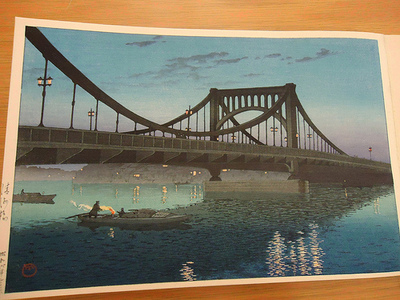- Born: 1883/5/18, Tokyo
- Died: 1957/11/7
- Other Names: 川瀬文治郎 (Kawase Bunjirou)
- Japanese: 川瀬巴水 (Kawase Hasui)
Kawase Hasui is among the most famous of the shin-hanga woodblock print artists. He was recruited by publisher Watanabe Shôzaburô in 1918, and, employing a combination of traditional and modern (Western) techniques and materials, he designed countless landscape scenes imbued with the romance of a "traditional" Japan.
Born and raised in Tokyo, Kawase Bunjirô later took on the art-name "Hasui." He trained in Nihonga painting under Araki Kan'yû and Aoyanagi Bakusen, and in Western painting (yôga) with the White Horse Society Aoibashi, before becoming a disciple of Kaburaki Kiyokata. In 1918 he received his first commission from Watanabe Shôzaburô's company - three pieces. He remained associated with Watanabe's firm throughout a lengthy career, but many scholars feel that his best work was produced between 1918 and 1923.[1]
References
- "Kawase Hasui." Digital-ban Nihon jinmei daijiten デジタル版日本人名大辞典. Kodansha, 2009.
- Mason, Penelope. History of Japanese Art. Second Edition. Pearson Prentice Hall, 2005. p384.
- ↑ Mason. p384.
